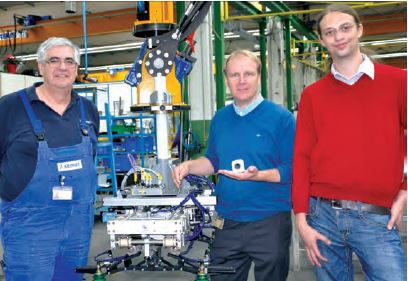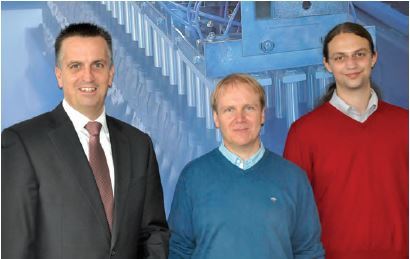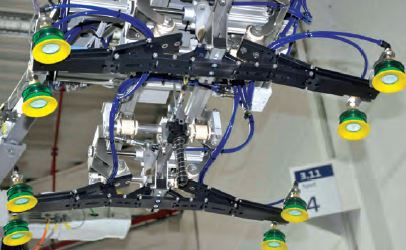Engineers used bionic findings and the design adventures of plastic bearings to develop butterfly grippers for packaging beverages.
When beverage containers are stacked, layers of cardboard lie between individual levels. This stabilises the stacks, even high towers. However, these intermediate layers are diffi cult to grip. Clever developers at Krones have come up with a tool for this purpose вҖ“ they resorted to bionic findings and used the design advantages of special plain bearings made of plastic. Those who build facilities for beverage manufacturers have to think about the spacers between bottle containers. At its Rosenheim plant, Krones AG has developed special packaging grippers which grip neither the bottle nor its container, but rather the intermediate layers of the pallet, as well as the pallets, top frames and hooded lid.

вҖңDue to the groove structure, the dirt is conducted right through the
igus linear plain bearings RJMP-01-25,вҖқ explains Peter Kirschner
who is responsible for the pallet gripping system at Krones in
Rosenheim.
Why plastic for the gripper?
The plastic plain bearings play a classic role for the movements of the gripper. Peter Kirschner, head of the Krones team that developed the specially aligned pallet gripping system, prefers this solution because the plastic bearings are lightweight, cheap and very rugged. In conjunction with igus вҖ“ a Germany-based manufacturer and distributor of plastic plain bearings, spherical bearings, linear guides, cable carriers and continuous-fl ex cables вҖ“ Krones developed a hexagonal bearing for the so-called hook gripper, which can grip an entire layer of beverage crates.
Less is more
Each application has its own characteristics and relies on the special abilities of the plain bearings. Every user sets his/her own priorities.
вҖңNot everyone needs a lightweight bearing,вҖқ said Tobias Vogel, who is responsible for the distribution of igus plain bearings in Cologne, Germany. But for him, light weight is more than just a вҖҳnice to haveвҖҷ feature.
вҖңThe physical cognition of the moving masses is also true for gripping heads, the beverage pallets, and everything that go with it, which should be gripped. Sometimes less is more вҖ“ especially with low weight,вҖқ said Vogel. What is lighter can be moved easier and faster.
Design details
The designers of the gripper for palletizing also took into account the small design details of the plain bearings. One particular innovation in the eyes of Kirschner is the segmented bearing. вҖңThe bearings free themselves from dirt, which is a breakthrough for us,вҖқ he said.
In the application, a special gripper has emerged out of it. For this packaging gripper, the developers of the Krones gripper systems have come up with special bearing blocks for the small, segmented plain bearings. вҖңA great innovation developed out of the joint work,вҖқ said Kirschner. вҖңThe solution has less weight with the same functionality and saves cost compared to other alternatives. We have not patented it, but we are the only ones that use plain bearings in this way.вҖқ Especially for the вҖҳstarsвҖҷ under the packaging grippers, this system has proven its worth. For the so-called butterfly grippers, the Kirschner team has taken some principles from nature and achieved not only in terms of efficiency and high performance.
Bionics meets gripping technology
The butterfly gripper uses the Fin Ray effect. When it lifts the cardboard layers, the gripper works like the model of the dolphin, which applies great forces by the arrangement of its fish bones while swimming. But how do the butterfly grippers get its name, when it is derived from a fish?
вҖңWhen the gripper lifts the intermediate layer, it looks like the flapping of butterfly wings,вҖқ Peter Kirschner described the effect. вҖңInitially, we kept the name Fin Ray grippers, which is technically correct. However, the butterfly has prevailed in the parlance, and now its official name is butterfly gripper.вҖқ
The gripper head is mostly used for disposable bottles. In order to keep the pallet towers stable for plastic bottles in shrink packs, the gripper also sets the intermediate layers. Since the cardboard boxes are delivered in the stack, the individual layers lie closely compacted together, which makes it difficult to grip.
вҖңSo far, the intermediate layers could be cleanly separated only by a brush magazine and inserted between the beverage layers,вҖқ explained Peter Kirschner. вҖңAs soon as the vacuum gripper lifts one layer, the brushes prevent the underlying, closely pressed intermediate layers from moving along.вҖқ However, these brush magazines cost a lot of money.
The bionic gripper head gets the job done without the costly brush magazine. It lifts the sides up, and the underlying vacuum is relieved. When it grips and then stretches both sides again to lay down the intermediate layer on the product stack, it imitates the butterflyвҖҷs motion on air.
Lifting like a butterfly
But how does this aesthetically appealing movement come about in the gripper? вҖңThe entire assembly is pushed to the side via a tube as a guide. In a kind of pulling effect, the butterfly operation is created by the movement of the plain bearings. Thereby the pneumatic cylinders move together and the distance between the individual links is reduced,вҖқ said Benjamin Benninghoven, describing the вҖҳbutterfly effectвҖҷ.
The clear advantage of this gripping technology is that the intermediate layers can be moved free from the stack to exactly where they are needed without further handling. The gripping according to the bionic Fin Ray principle, however, masters only one type of packaging grippers, which should be continuously improved. вҖң
The new versions weigh less by the use of more curved sheet metal instead of welded steel parts. By the application of plain bearings in more points, the design is also improved,вҖқ said Benninghoven.

The вҖҳfathersвҖҷ of the butterfl y gripper at Krones in Rosenheim:
Johann Berger, Peter Kirschner and Benjamin Benninghoven (from
left to right).

igus sales manager Tobias Vogel with Peter Kirschner and
Benjamin Benninghoven of the pallet gripping system team (from
left to right).
Gripper for all cases
The team of Peter Kirschner has set out to develop a modular system for each type of gripper. вҖңWe optimize these construction kits and do not begin a product redesign for each customer. That would be less effective. Today we can effectively assign our grippers according to the application and tailor precisely to the customerвҖҷs needs in modular fashion.вҖқ One of these construction kits is the butterfly gripper.
Plain bearings for construction kits
The fact that the plain bearings are an inspiration for these developments is a matter of course for team head Peter Kirschner. Also, traditional вҖҳpackaging grippersвҖҷ benefit in operations by the use of additional plain bearings. For example, if more than just intermediate layers should be gripped. Then these are no butterfly grippers, but normal grippers that have been rendering their services for decades. But even this вҖҳnormalвҖҷ is better.
вҖңToday, we design all our free grippers according to the modular principle,вҖқ said Kirschner. вҖңThis works so well because here we use plastic bearings that simply fit the modular concept better than other solutions.вҖқ
An important minor issue
The gripper systems for packaging aids must work 100 percent. Thereby, the users take the word вҖҳaidsвҖҷ very literally.
вҖңPackaging aids processing is often dismissed as a minor matter,вҖқ Kirschner described the work with partially incomplete specifications. вҖңWithin its course, the order coordination itself can sometimes be performed only with some assumptions. At times, a customer knows only at the last moment what he wants to process. But in the end, everything must of course still operate, or the system stops. The requirement is a functionally reliable yet inexpensive design. If in doubt, we can also add one or the other safeguards to ensure that everything fully works for the customer.вҖқ
For Kirschner, it is beyond question that the igus bearings fit into this concept. вҖңThey are extremely durable, there have been no complaints.вҖқ With the previously used ball bearings, the gripper specialists at Krones have had different experiences. вҖңA collision could destroy such bearings. The balls are often pressed into the shaft. Plastic plain bearings no longer trouble us with these problems, because a smooth surface meets another.вҖқ
Resistant to dirt and impacts
Kirschner said the bearings could withstand impact and dirt. They also defy strong vibrations or extreme weather conditions. This, in turn, leads to minor innovations, such as the specially segmented design of the bearing. This feature has proven itself in a dusty environment. Usually the dust molecules that press against each other accumulate on the guide shaft. When the dust layer increases day by day, the diameter of the shaft increases. Thereby, the traversing movement is always sluggish due to the strong friction.
Everything runs better in the plain bearing with the slits. There the dust does not accumulate in the bearing, but is guided literally through the bearing without significant changes in friction and wear behavior. вҖңThese bearings are perfect for such cases,вҖқ said Kirschner. However, there were no such solutions available earlier. вҖңigus has discovered these applications for the plastic plain bearings and for this, presented its own special designs such as the lead through of the dust in the bearing.вҖқ

The butterfly gripper is a proprietary construction kit, which is
joined in modular fashion from small assemblies according to the
gripping task.

According to the customerвҖҷs product, an appropriate gripper head
can be selected from the Krones range. The construction kit allows
customized adjustment.
The lead through of dirt in the bearing
How does dust/dirt lead through operates in the bearing? Tobias Vogel said: вҖңThe origin of the so-called linear bearings were the вҖҳL1вҖҷ plain bearings. Here we have split the bearing into a guiding and a non-guiding part. Film bridges between the individual guide bars compensate for this effect caused by heat and moisture. Behind it is the idea, regardless of the environmental conditions, to always guide in a straight line.вҖқ
The subdivision is useful not only for tolerance compensation, but dust and dirt are led through the bearing in a much better way and are not caught in between the two gliding surfaces. This development has spread out at igus. Linear guide laminations benefit from it, and linear solid plastic bearings, as used in the butterfly gripper, are beneficiaries of these design principles: they are built with bars at different heights. Coarse dust and dirt are guided through without a shaft getting blocked or jerky.

 Industry News
Industry News



